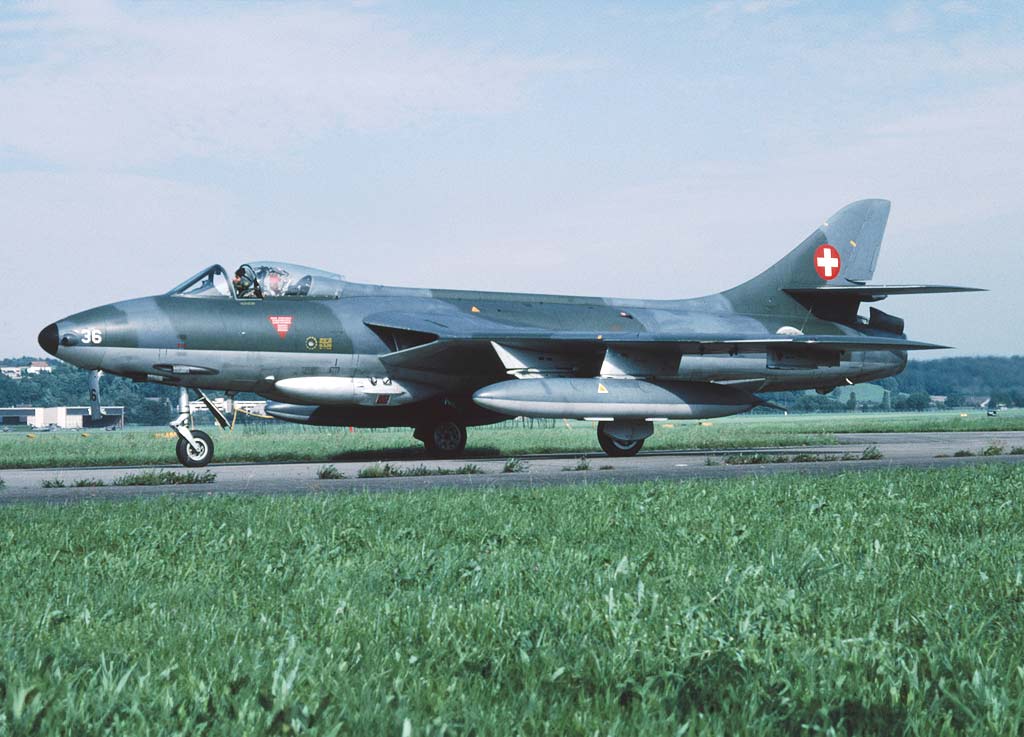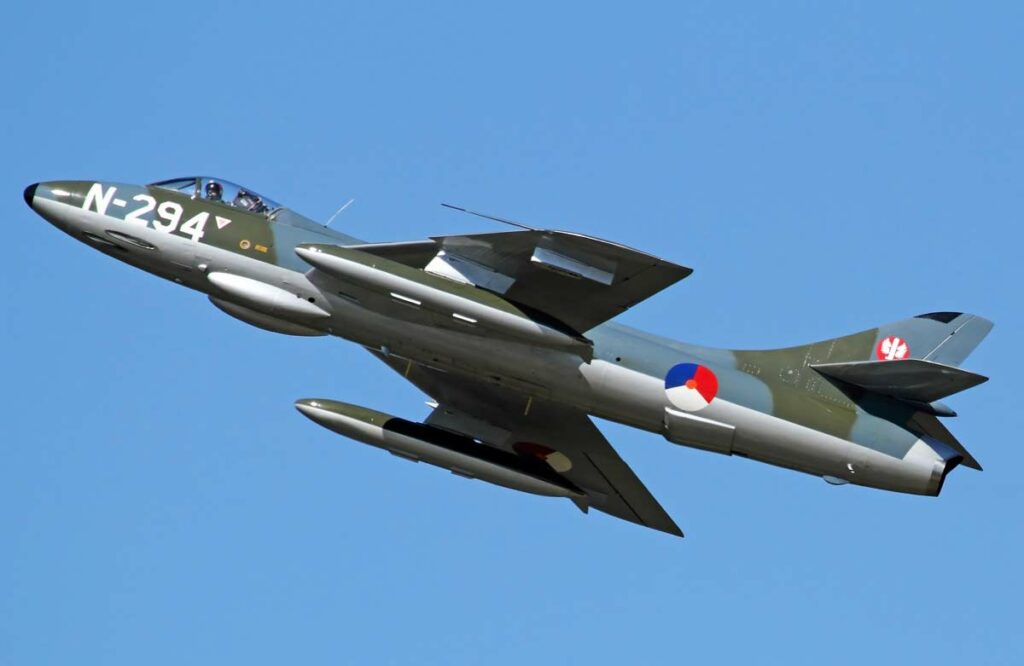The Hawker Hunter, a classic British jet fighter, is known for its swept-wing design, high speed, and operational versatility.
In brief
The Hawker Hunter is a British jet-powered fighter aircraft developed in the early 1950s. A quintessential example of post-World War II aviation technology, it was designed for high-speed, high-altitude interception and ground attack missions. The Hunter stood out for its sleek design, powerful Rolls-Royce Avon engine, and remarkable agility, making it one of the most successful British fighter jets of the Cold War era. It was widely exported and saw extensive service in numerous air forces worldwide, participating in various conflicts. The Hunter’s combination of speed, firepower, and reliability ensured its long operational life and popularity among pilots.
The Hawker Hunter is an iconic representation of British aerospace engineering, developed during a pivotal era in military aviation history.

History of Development
In the context of the rapid advancements in jet technology post-World War II, the United Kingdom needed a new generation of fighter aircraft to maintain its military prowess. The Hawker Hunter was developed in response to this need, with the program initiated by Hawker Aircraft Ltd. under the leadership of Sydney Camm.
The development objective was to create a jet fighter that could surpass the speeds and altitudes achievable by piston-engine fighters. The program was launched in the late 1940s, culminating in the Hunter’s first flight on 20 July 1951. The aircraft was a response to the evolving nature of aerial combat and the strategic necessities of the Cold War era, designed to counter the perceived threats of the time.
Design
The Hawker Hunter featured a revolutionary design for its time. It was equipped with a swept-wing layout, a characteristic of early jet fighters, which provided high-speed performance and stability. The aircraft measured 45 feet 11 inches (14.0 meters) in length with a wingspan of 33 feet 8 inches (10.26 meters). It was powered by the Rolls-Royce Avon turbojet engine, delivering robust thrust and reliability.
The Hunter’s design allowed for a maximum speed of 715 mph (1,150 km/h) and a service ceiling of 50,000 feet (15,240 meters). Its armament included four 30 mm ADEN cannons, with provisions for bombs and rockets under its wings, making it a versatile platform for both air-to-air and air-to-ground combat.
The design, however, had limitations, including early issues with high-speed handling and fuel consumption. Despite these challenges, the Hunter’s overall performance and adaptability made it a significant advancement in jet fighter design.
Performance
In terms of performance, the Hawker Hunter was a standout fighter of its era. The Rolls-Royce Avon engine provided the Hunter with a maximum speed of 715 mph (1,150 km/h) at altitude, and it had an operational range of 445 miles (715 kilometers). The aircraft’s climb rate and service ceiling allowed it to engage enemy aircraft effectively at high altitudes.
Compared to contemporaries like the Soviet MiG-15 and the American F-86 Sabre, the Hunter held its own in terms of speed and maneuverability. Its performance in various international air exercises demonstrated its capability as a top-tier fighter jet.
Variants
The Hawker Hunter saw several variants over its service life, each designed for specific roles. Key variants included the Hunter F.1 (the initial production model), the F.6 (with improved wing design and engine), and the ground-attack oriented FGA.9. Each variant brought enhancements in performance, armament, and operational roles, catering to the evolving needs of the air forces that employed them.

Military Use and Combat
The Hawker Hunter was used extensively in military operations across the globe. It saw combat in numerous conflicts, including the Suez Crisis, Indo-Pakistani Wars, and the Rhodesian Bush War. The Hunter’s armament, consisting of powerful ADEN cannons and a variety of air-to-ground munitions, made it effective in both air superiority and ground attack roles.
The aircraft competed with various contemporary fighters and often held a competitive edge due to its superior speed and firepower. The Hunter was exported to many countries, significantly impacting air force capabilities in regions like the Middle East, Africa, and Asia.
As newer technologies emerged, the Hunter was gradually phased out from front-line service. However, it continued to be used in secondary roles and by several air forces into the 21st century, a testament to its enduring design and capability.
The Hawker Hunter remains a significant chapter in the history of military aviation. Its development, operational history, and legacy reflect the technological advancements and strategic demands of the Cold War era. The Hunter’s longevity in service is a tribute to its robust design and adaptability, securing its place as one of the most successful and revered jet fighters of the 20th century.
Back to the Fighter Jet section.